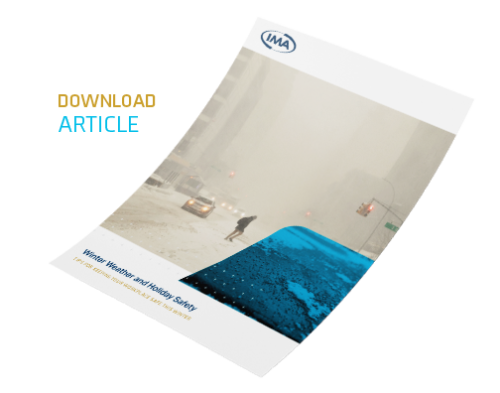Winter Weather and Holiday Safety
Tips for keeping your workplace safe this winter
Winter weather has made an entrance and the holidays are approaching. Are your workforce and your facility prepared for the winter weather? Here are some winter weather safety tips.
Your Winter Weather Plan
To maintain productivity and reduce injuries and time off, consider winter safety and create a plan for your facility. A little time spent planning can go a long way. Consider things like:
- Equipment Location: Where are the shovels, snow brooms, salt, wet floor signs?
- Employee assignments: Who should stay home? Who will do the following: plow, salt, check for slip mats, inspect areas, escort customers.
- Inspections: Will managers inspect footwear? Will an employee be assigned to check a doorway each hour?
- Snow removal plan: Does everyone understand the process before the big storms roll in?
- Employee Training: Does everyone understand not just the plan, but best practices for staying safe in winter weather?
- Communication of Plan Activation: How do we let employees know that we are activating our winter weather plan?
Keeping Your Facility Safe
Assess Your Floors
If you’re like many facilities, you have to deal with rainwater in the loading dock, ice in the parking lot, or entry mats that have bubbled up over time. Don’t stand by when you can be taking preventative measures. Assess things like:
- Do we have entry mats at each entry door?
- Are staircases coated with grit?
- Is the floor slip-resistant?
Turning on the Heat
- Check smoke and carbon monoxide detectors (both at work and at home). As furnaces see more use, there is a greater chance of a fire.
- Monitor your facility’s use of space heaters to make sure they’re used safely. Dive into space heater safety in this article.
- Continue your monthly fire extinguisher inspections.
Who’s In Charge?
- If you have the resources to do so, designate an employee to be in charge of making rounds through the facility on a continual basis.
- If you do not have the personnel to assign someone to these tasks, make sure to schedule time in the day for housekeeping activities.
Keeping Your People Safe and Healthy
Slips Trips and Falls
Here’s a winter scenario for you: During an accident review at a safety committee, you discuss a recent injury where an employee slipped and fell on the ice while walking to their car.
The first questions to ask would be, did you make a serious attempt to get to the root cause of that slip? All too often we say to ourselves, “We plowed the lot and spread salt. Is there much more we can do?” The answer is usually yes. Here are some recommendations to help you eliminate winter slips trips and falls.
Develop a Footwear Policy
- Develop a written policy that will go in the company handbook and be made available to all employees. (Because tennis shoes do not make for good snow shoes.)
- Personally communicate the policy to each employee. This in-person communication provides employees the chance to voice their concerns about the policy and a chance to ask questions.
- Ensure employee sign-off, confirming that the policy was communicated clearly to every employee. This is helpful if you need to consider discipline for a violation.
Inspect Footwear
- Ensure your employees wear appropriate footwear for the conditions outside.
- Conduct department inspections to make sure employees have the proper footwear. Use an employee roster and check off each member that owns the proper footwear. This will ensure them that the company is taking the policy seriously as any injury can affect everyone.
- Reference your PPE plan for the proper protocol if an employee does not own the proper footwear, (Keep in mind a $40 pair of boots cost much less than surgery after a fall.)
- Consider providing over-the-shoe snow spikes, which do great in the snow. However, you must take them off as soon as you get inside or you could slip very easily on a smooth concrete floor.
Illness Prevention
If we’ve learned anything over the last few months, it’s the toll illness can take on your workplace. So, let’s make sure we do everything we can to protect our workforce.
- Develop an Infectious Disease Preparedness and Response Plan. Contact KPA if you’re interested in learning about our Infectious Disease Preparedness and Response Plan templates.
- Practice proper workplace hygiene. This includes washing hands for 20 seconds, avoiding touching your eyes and face, sneezing into your elbow; and covering coughs.
- Increase cleaning, disinfecting, and sanitation. Wipe high touch surfaces, such as time clocks, throughout the workday.
- Reduce transmission. Have symptomatic employees stay home.
Holiday Safety
The holidays are generally a time of happiness and celebration, but they can also provide extra hazards and stress. Keep some of these pointers in mind for a safe and happy holiday season.
- Just like smoking, lit candles have no place near machinery or chemicals (and should really just stay home altogether).
- If you’re hosting a holiday party, keep in mind driving and alcohol. Designated drivers ensure your employees will be able to enjoy holidays in years to come.
- The holidays can be a stressful time for your employees. Be mindful of external pressures during this time of year.
- And finally, about that Christmas tree. Cut root trees can be a serious fire hazard. Make sure the needles are cleaned up, the tree is continuously watered, and the tree is disposed of when it’s dry. Also, keep in mind the International Fire Code prohibits cut root trees in areas where groups of people assemble unless the building has approved sprinklers. Some towns may even require a permit!
